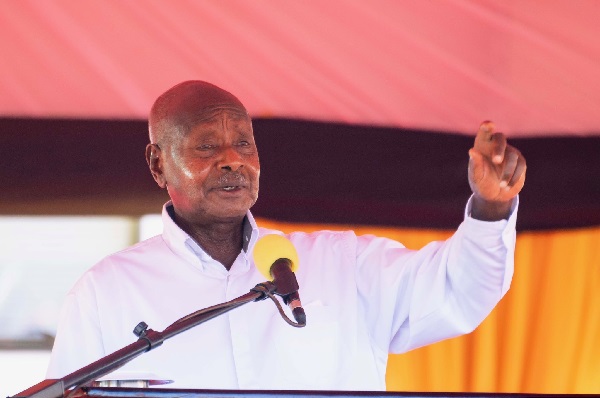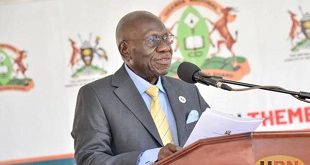
Kampala, Uganda | THE INDEPENDENT | President Yoweri Museveni has said Uganda’s mineral and agriculture sector have the potential to spur the country’s economy to match some of the top countries in Africa.
“Our aim is to catapult the economy from USD 55 billion to USD 500 billion in the near future by harnessing the country’s resources and workforce while combating corruption,” he said in his remarks after Minister of Finance, Planning and Economic Development presented to the nation the National Budget.
“In a short-while to come, our petroleum will start coming from the ground. This will enable the Government to earn an extra USD 2billion, assuming today’s prices. This is apart from other income streams to the country,” he said, adding that “this oil money will never be used for consumption. It will only be used for infrastructure and science development. Therefore, strategic items like the railway and the irrigation will be funded by us directly.”
The 72 trillion-shilling 2024/2025 budget is relatively unique and historical, being more than one third of the country’s economic output (GDP) and also due to the biggest increase ever (almost 14 trillion shillings) over the outgoing budget.
The year 2024/2025 is the fifth and final implementation year of the third National Development Plan (NDP3) which has driven the economy to about 55 billion dollars, according to President Yoweri Kaguta Museveni, adding 15 billion dollars over the last five years.
According to the Finance Ministry, by the end of the next five years, the NDP4 currently under finalisation, will kick off the bid to add 450 billion dollars to leave the country at a super economic level of 500 billion dollars by 2040.
This would put the economy just below Israel, Norway and Singapore by their current GDP figures, and above Philippines, Vietnam, Iran, Bangladesh, Malaysia and Denmark,as well as, of course, South Africa and Nigeria, going by the IMF 2024 figures.
With an estimated 8 million people to be added to the current population, the GDP per capita will rise from the current estimate of about 1,081 to at least 7,000 US dollars by 2039/2040.
President Museveni assured the country that this is even achievable before that date, because of the anticipated enhanced value addition to major commodities like coffee, minerals, forest products, and others, which should reduce the country’s import levels.
The budget has also identified four anchor sectors to drive growth; agro-industrialisation, tourism development, mineral development including oil and gas, as well as science, technology and innovation, including ICT.
The budget will be funded by domestic resources worth 31.98 trillion shillings, with 29.3 being tax revenues and the rest non tax revenues.Domestic borrowing will be raise 8.968 trillion, while the government will also issue Treasury Bonds to raise 7.78 trillion to pay of Bank of Uganda.
Domestic refinancing will amount to 22 trillion while project support by external financing will raise 9.58 trillion shillings.
Another 115 billion will be drawn from the Petroleum Fund, while Local Government Revenues are expected to total 293 billion shillings.
The 2024/2025 budget is the first year towards that feat and Minister Matia Kasaija says to achieve this, the economy will have to grow double every five years.
Background to the new budget shows that the economy sustained recovery from the effects of COVID-19, growing at about 6 percent in 2023/2024, which was faster than the 5.3 percent recorded for last year, and the 4.6 percent for the year earlier.Subsequently, the per capita GDP in 2023/2024 is estimated at about 1,146 US dollars compared to 1,081 dollars in the financial year, 2022/2023.
In coming up with these 2024/2025 targets, the government hopes to increase domestic revenue collection from the 27 trillion shillings that URA expected to have collected by June 30th this year, to about 32 trillion shillings next year.
According to the ministry, the resources available for expenditure next financial year and in the medium term will be obtained from both domestic and external sources. “This will include domestic revenue (tax and non-tax revenue), draw down from the petroleum fund, domestic borrowing, budget support grants and loans, as well as project support (grants, concessional and non-concessional loans),” it says.
The resource envelope, net of arrears and domestic debt repayments, is projected to amount 37.829 trillion shillings.
Other strategic objectives and actions include reduction of total public debt in nominal terms to below 50 percent of GDP by financial year 2025/26, as per the Charter of Fiscal Responsibility.
It also aims to gradually adjust the overall fiscal balance including grants to a deficit not exceeding 3 percent of GDP (excluding the oil contribution), by 2025/26.The charter also targets transferring a maximum of oil revenues worth 0.8 percent of the preceding year’s estimated non-oil GDP outturn to the Consolidated Fund for budget operations.
The balance is to be transferred to the Petroleum Revenue Investment Reserve (PRIR) for investment in accordance with the Public Finance Management Act (PFMA) (2015) as amended.
To achieve these, the government will have to ensure interventions to increase domestic revenue mobilisation, reduce wasteful expenditures, reduce “inefficiencies in the health and education sectors”, improving project implementation efficiency and reducing borrowing from external commercial sources,among others.The expected increase in domestic revenues is pegged on an anticipated increase in economic growth, new tax revenue measures and improved tax compliance and administration.
This is on account of new recruitment at the URA and the introduction of digital systems for tax collection such as the Electronic Fiscal Receipting and invoicing Solutions (EFRIS).
The government is also aware that resources in form of grants and concessional loans are projected to reduce significantly from 2.78 trillion in 2023/2024 to 1.394 billion next financial.
“This reduction is due to government’s deliberate decision to reduce commercial external borrowing in an effort to maintain fiscal and debt sustainability,” it says.Yet, amortisation of external debt is projected to increase from 2.638.6 trillion as approved in the approved budget for 2023/2024 to 3.108 trillion shillings next year, (equivalent to 1.4 percent of GDP). It is expected to continue rising to an average of 1.9 percent of GDP by 2028/2029.
****
URN
 The Independent Uganda: You get the Truth we Pay the Price
The Independent Uganda: You get the Truth we Pay the Price



Yoweri Museveni a proper son of Africa!